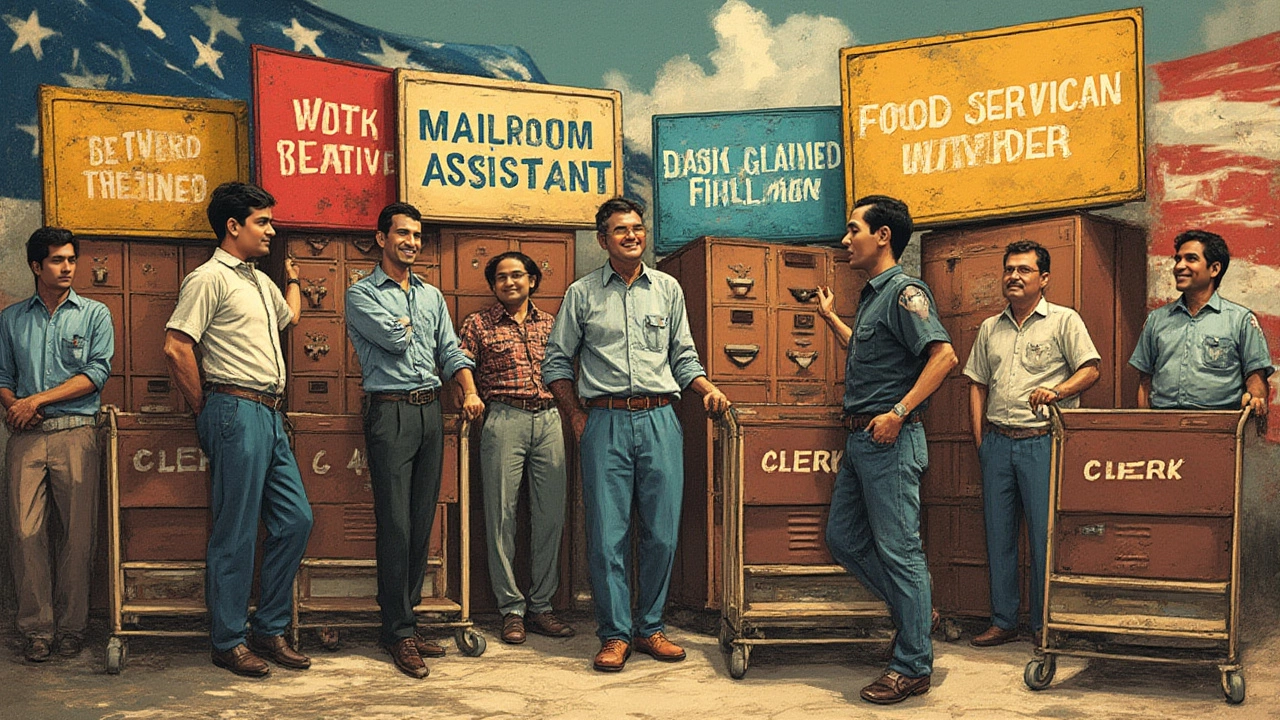
Lowest Paying Federal Government Jobs: Pay Scale, Duties, and Realities Explained
So, you might think working for the federal government guarantees a cushy paycheck, but let’s shatter that assumption. Some folks working for Uncle Sam make less than what’s advertised at the golden arches down the street. For anyone desperately searching for a fresh start or just some job security, knowing how low the federal pay floor drops matters. Sure, government jobs have a reputation for stability and decent benefits, but not everyone in the federal workforce is cashing in big. Now, if you’re picturing a White House staffer or a seasoned agent, forget it. We’re talking about jobs at the absolute bottom of the federal pay ladder.
The U.S. government hires over two million civilian workers. While a handful pull in six figures, thousands more are grinding away in less-glamorous, entry-level roles. What is the actual lowest paying job you can clock in for on federal payrolls? Why are some salaries so incredibly low, and who takes these roles? And maybe the bigger question: Do these positions ever lead to something better—or are they dead ends wearing Federal IDs?
Breaking Down the Federal Pay Scale: Who Makes the Least?
Let’s start with something concrete—the General Schedule, or GS, pay scale. Nearly 70% of federal civilian jobs use this system, which ranks positions from GS-1 (the lowest rung) up to GS-15 (the highest). Within each ‘grade,’ there are steps, so you can climb a little without switching jobs. But at GS-1, Step 1, you’re officially at the bottom.
So what’s the paycheck look like for a GS-1, Step 1 worker in 2025? According to official data released by the U.S. Office of Personnel Management (OPM), the base annual salary starts at $22,613. Keep in mind, that figure often increases due to locality pay, depending on where you work—someone assigned to the Bay Area will earn a bit more than someone in Iowa. But even so, GS-1s aren’t living large.
The government rarely hires people at GS-1 these days, but the pay table is there, and if you snag a job as a ‘Laborer’ or ‘Mail Room Clerk,’ you might find yourself at that level. Here’s how a GS-1 salary compares to local minimum wage jobs across America:
| Location | GS-1 Step 1 Annual | Local 2025 Minimum Wage |
|---|---|---|
| Los Angeles, CA | $26,054* | $16.90/hr ($35,152) |
| Kansas City, MO | $23,627* | $7.25/hr ($15,080) |
| Washington, DC | $26,771* | $17.50/hr ($36,400) |
* Includes 2025 locality adjustment estimates
Notice how, in some regions, even the federal wage can trail local entry-level pay. Federal jobs do bring better health benefits, paid vacation, and retirement plans, but the take-home numbers aren’t mind-blowing at first glance.
Most GS-1 jobs ask little in terms of education or training. We’re talking about basic custodial work, mail sorting, food service positions in federal facilities, or laborer gigs. The job descriptions are straightforward and rarely come with surprises. Applicants usually need a high school diploma, or even less. Examples of official job titles in this range include:
- Laborer (Custodial)
- Food Service Worker
- Mail Clerk
- Park Aide (Seasonal hires, especially by the National Park Service)
Keep in mind, the government’s official jobs site, USAJOBS, reflects this. Search for ‘GS-1’ there and you’ll see it’s not a popular starting point anymore, but the titles and salaries are still on the books. For young folks, people changing careers, or those willing to trade earning potential for job security, these jobs can be a soft landing pad. But, let’s be honest, living in D.C. on a GS-1 salary will test anyone’s budgeting skills—and maybe their sanity as well.
Is it any wonder so few people actually spend their careers as GS-1s? Here’s a fun fact: data from the OPM shows that fewer than 0.5% of all federal civilian employees are in GS-1 positions, with most either moving up quickly or leaving for other work. It’s almost like it’s meant to be a stepping stone, not a destination.

Why Does the Government Keep Such Low-Paying Jobs?
If GS-1 jobs pay so little, what’s the point of having them at all? It comes down to two things: structure and opportunity. The GS system is built to recognize every rung of skill and responsibility. By keeping GS-1 and GS-2 on the books, they make space for literally ‘anyone’ to apply to federal work, whatever their background.
And yes, sometimes these jobs are reserved for specific groups—think student programs, internships, or positions for individuals with disabilities. The low pay isn’t just about labor cost; sometimes it’s an incentive to encourage growth and internal mobility. People who start as GS-1s often see regular increases as they rack up experience or move into higher grades.
It doesn’t hurt that, compared to private employers, the federal government is more transparent about pay and advancement. The government posts all the numbers right up front, with job descriptions, pay tables, even the steps for promotions. Applicants know exactly what they’re getting when they sign on: the good, the bad, and the bureaucratic.
Think about the sort of tasks you tackle as a GS-1. Maybe you’re keeping government offices tidy or making sure the mail cart doesn’t go astray. But the responsibilities can increase fast. Supervisors and department heads keep an eye on the most reliable and ambitious helpers, and the government is known for its “in-shop” promotions—meaning, if you show up, work hard, and avoid trouble, better things often come your way.
Another reason: not every region in America has sky-high living costs. In smaller towns or rural areas, that paycheck stretches a lot further. Pair that with the government’s steady health insurance, and it’s a stronger value proposition than the paycheck alone suggests. You don’t have to worry about your job vanishing if a branch closes down the way you do in retail or fast food.
By law, the government can't pay less than the federal minimum wage for hourly equivalents, so GS-1 always matches or exceeds that threshold—if only by a hair in some places. Of course, some labor unions have fought to raise entry-level government pay, arguing it helps with retention and morale. Those efforts have moved the numbers a bit over the past decade, but GS-1 remains, intentionally, at the ground floor.

Tips, Realities, and Alternatives: When (and Why) You Should Take the Plunge
So, if these entry-level jobs don’t scream “financial freedom,” why do people take them? Sometimes, a federal job at any level is a strategic move. Veterans, recent grads, or those switching industries often apply to GS-1/GS-2 jobs knowing it’s just their ticket in. The federal system is sticky—once you’re in, climbing up the ladder gets a lot easier.
For anyone serious about government work, here are a few insider tips for turning even the lowest paying job into a launch pad:
- Leverage that status: Internal applicants (even those hired at GS-1) can apply for many jobs that outsiders can’t touch. Priority status is a real thing, and it pays off fast if you’re ambitious about moving up.
- Don’t wait to apply for promotions: After spending 6-12 months and showing good attendance, you (or your kid, or your neighbor) can apply for higher-grade work. Most supervisors encourage this—it saves them search time and helps staff stick around.
- Look at special hiring authorities: Certain programs—like Pathways internships for students, the Schedule A program for applicants with disabilities, or roles for former military—offer noncompetitive pathways to permanent higher-level jobs.
- Bank those benefits: Even the lowest grade gets federal health insurance, life insurance, paid federal holidays, and sick leave. Dollar-to-dollar, a GS-1 job’s “real” compensation beats a lot of minimum wage alternatives, especially when you run the numbers for health coverage.
- Aim for agencies with better locality pay: Some jobs in expensive cities pay a lot more just for being there. For example, a GS-1 worker in San Francisco or DC will bag thousands more per year than one in the Midwest.
That said, not everybody is cut out for low-paying government gigs. There’s bureaucracy, rigidness, and sometimes mind-numbing duties. Still, I’ve had friends—Rachel included—who used temporary, entry-level federal jobs to pivot into lasting careers. She started as a seasonal clerk at a national park and within three years, she’d climbed into positions that paid double—and loved having a solid health plan to boot.
The secret is, the government’s wage system isn’t really designed to keep people at the bottom. A GS-1 can become a GS-5 or GS-7 in a couple of years with some effort. But you have to be proactive: volunteer for extra shifts, sign up for agency training programs, or help out with new office projects. Supervisors notice this stuff, and many are eager to reward people who show up ready to help.
For the data nerds out there, as of 2024 OPM reports, fewer than 1,200 people nationwide hold GS-1 status year-round. The agencies with the most GS-1s are the National Park Service, Department of Veterans Affairs, and a handful of smaller offices. But most last only a year or two in those roles before moving up, which says something about real-world hiring and advancement practices.
If you’re thinking about jumping in, the best advice is to set expectations—GS-1 or GS-2 is not going to make anyone rich, but it’ll crack open doors that can lead to bigger things. And if you pair that government badge with a smart application game plan, you just might land the kind of job that not only pays the rent but offers a sense of purpose, too.






Write a comment